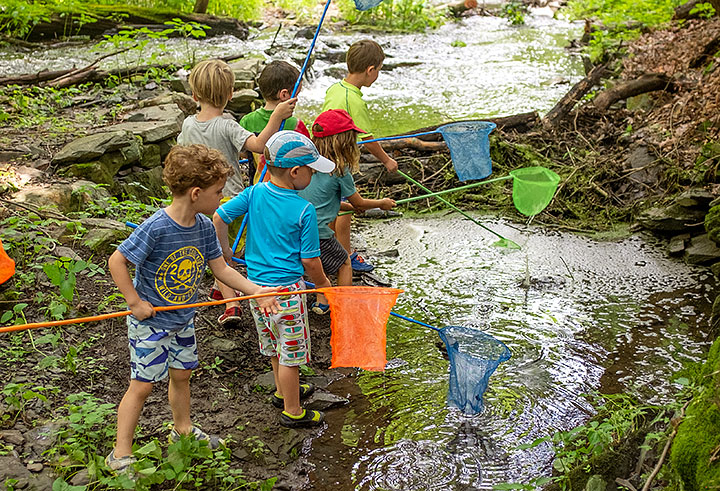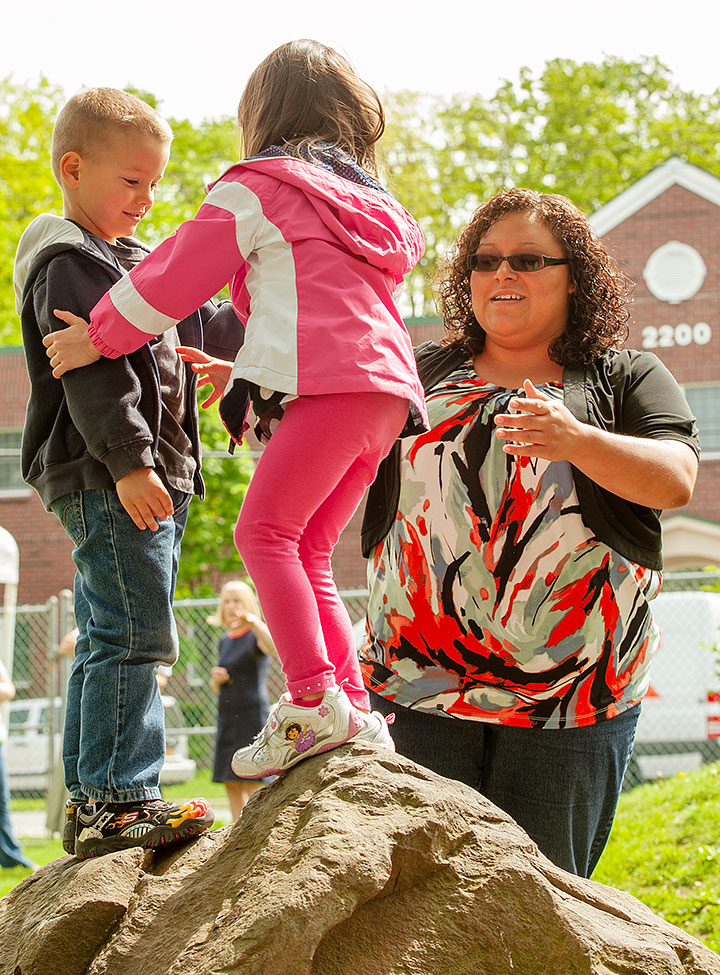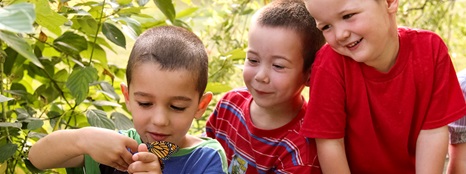Out to learn
A Beginner’s Guide to Learning Outdoors
| June 2021Juliet Robertson’s book, Dirty Teaching: A Beginner’s Guide to Learning Outdoors, is packed full of practical ideas, activity suggestions and inspiration about outdoor learning and play. Whet your appetite by reading extracts from the introductory chapters.
Preface
You could have heard a pine needle drop in the wood. Thirty children sat silently, scattered among the trees. Some were lost in thought. Others were scribbling notes on scrap paper. It was hard to believe that this was taking place on a still January day, five degrees below zero.
Sheltered by the young trees, we gathered to share our work. In turn we read out our chosen lines. Together we created a group poem, where every child’s contribution was welcomed and valued. There was a magical, spine-tingling feel to the whole experience that was felt by all.
It did not start out this way. When I saw the children come out of the school building, I knew immediately it was one of those classes. The sort that challenge, question and push a teacher to the limit.
After a quick warm-up listening activity, we moved through the forest which had been planted around the perimeter of the playing field a decade earlier. The children were still tuning in to being outside. They rushed along the path, ignoring the task given to them. Some of the boys were pushing and shoving each other. This was not intentional bad behaviour. They were just excited.
So that’s how we came to be writing poetry and listening to the sounds of silence. In the woodland, each child found a place where they could sit far enough away from the others. They had time to let those thoughts and feelings surface. Calm descended. The special nature of the outdoors had finally captured this class.

Make learning sticky
If you consider your own time at school, the chances are that your strongest memories will be about your time outdoors. This will include residential stays, excursions and playtimes. For some reason, we appear to remember more outdoor activities even though it is quite likely we spent less time outside than in.
Such memories are important for two reasons. Firstly, there is an onus on us to provide lessons in an environment that is conducive to learning, both in the long and short term. Common sense suggests that if being outside is more memorable, then this may be one way of helping children to remember what they have learned. Secondly, we need to consider why the memories stick. What is it about being outside that contributes to making an event memorable?
Chip and Dan Heath spent over ten years looking at why some ideas take hold and others are forgotten. In their book, Made to Stick, they suggest that there are six principles which make a story, headline or other experience impact on our memory. ¹ These are neatly summed up as the SUCCES formula: Simple, Unexpected, Concrete, Credible, Emotional, Stories.
An event or experience does not need to contain all of the principles which can be applied to any learning, outside or inside. However, they easily lend themselves to the outdoors. It is naturally ‘sticky’. For example:
Simple: Less is often more. Most activities outside rely on materials found in situ and the imagination of those involved.
Unexpected: Outdoor activities often end up being interrupted. A cat might walk through the playground. A patch of mushrooms may be discovered behind a bush. View these interruptions as a vital part of the lesson and go with the flow; even if your original learning objective is not met, another one can easily replace it.
Concrete: Outdoor experiences tend to link better to actual events, people and the community. Often practical skills are required. This makes the learning authentic and real.
Credible: Working outside seems to naturally lend itself to children’s lives and interests. The outdoors is multisensory so children acquire an understanding through using lots of their senses.
Emotional: This is the ‘ooh’, ‘ah’, ‘ugh’ factor. Not all time spent outside is pleasant but when you hear these sorts of sounds coming from your class, you know that a connection is being made. Learning is an emotional process as much as a cognitive one.
Stories: It is relatively easy to create a narrative of outdoor experiences. It is much harder to do this when sitting down and completing a page of work in an exercise book. We can use stories as a springboard to an outdoor activity – we can make up stories and act them out. Adventures are often recalled as narratives. Being mindful of these principles when planning outdoor experiences may help to make the learning memorable.

Why does learning outside matter?
Many adults who work with young people can give personal accounts of the enjoyment, freedom, creativity and inspiration that outdoor experiences offer children. The benefits of learning outside have been recognised and documented at least as far back as the fourteenth century.²
In the past two or three decades, a substantial amount of research has been undertaken which all points in the direction of humans needing nature not just to survive but to thrive.³ Our cognitive, social, emotional and physical health is affected by time spent outside, especially when in a natural space. This is why there is a growing emphasis on using green spaces, such as beaches and woodlands, in education. It is also why naturalising school grounds to increase plant cover and encourage wildlife makes a positive contribution to children's well-being.
The literature and research in this area suggest that outdoor learning, as part of a planned approach, may:
- Increase attainment in specific subjects.
- Impact positively on the health and well-being of young people.
- Help develop responsible citizens and lifelong appreciation of the natural world.
- Improve the social and communication skills of young people.
- Effectively weave together many of the strands of education for sustainable development.⁴
The parallels between all of the approaches to learning outdoors include:
- Interdisciplinary learning across subject areas.
- The use of the school grounds and local neighbourhoods, especially greenspace.
- Continuous visits over a long period of time, rather than one-off trips.
- Children involved in the planning and decision-making.
- Routines that develop skills and build independence.
- Teaching and learning in, through and about the natural and man-made world.

Value free play and take a playful approach to learning
“If you want creative workers, give them enough time to play.”
We have a paradox in schools. We accept the value of play, especially in the Early Years, but the idea of play in the primary sector and beyond often does not feel like a legitimate use of the precious time available.
For some children, school playtimes may be the only informal outdoor play opportunities available to them on a regular basis. It is a time for children to recharge their batteries between lessons. Some children find their lives are full of structured activities, such as music lessons and sports classes, or spend lots of time doing sedentary activities, such as playing computer games. Others may live in places where going out to play is not possible.
As part of developing learning outdoors, you can demonstrate that you value playtimes and facilitate daily outdoor free-play opportunities, regardless of the weather, season and the ability of a child to play with others or complete their work.
There are many different types of play. However, it is 'free play' which we need to encourage during breaktimes. Play is often described by play experts as happening when children choose what they want to do and how they want to do it. It is child-initiated and child-led with no external goals or rewards.⁵ This is how children learn to socialise, develop independence, improve their physical coordination and enjoy themselves without adults directing proceedings. It is how they learn about grit and resilience, power and control, to apologise and make friends.

As educators, we can look for opportunities to capitalise upon this and to acknowledge the contribution of playtimes to the rest of children's time in school. Children appreciate creative, as well as physical, play opportunities - particularly in nature-rich outdoor spaces. I often hear teachers and children comment positively about such experiences and how it helps children to be more settled and better able to concentrate when back in class. The health benefits associated with free play are numerous and include increased physical activity, improved physical and mental health, well-being, and social and emotional development.
Footnotes
- C. Heath and D. Heath, Made to Stick: Why Some Ideas Take Hold and Others Come Unstuck (London: Random House, 2007)
- R. Joyce, Outdoor Learning Past and Present (Maidenhead: Open University Press, 2012), pp. 11-21.
- Visit https://creativestarlearning.co.uk/support/outdoor-learning-research/ for links to some of the main outdoor learning research websites.
- Visit https://www.unesco.org.uk/education_for_sustainable_development to find out more about the United Nations Decade of Education for Sustainable Development.
- This is an abbreviated version of the definition given in J. Santer and C. Griffiths, with D. Goodall, Free Play in Early Childhood: A Literature Review (London: Play England and the National Children's Bureau, 2007). Available at: https://www.playengland.org.uk/media/120426/free-play-in-early-childhood.pdf, p. xi.
All extracts originally published in Dirty Teaching: A Beginner’s Guide to Learning Outdoors by Juliet Robertson (2014), Carmarthen: Independent Thinking Press.
To purchase this book or find out more about it, visit the Crown House website (includes a look-inside button).
Discover more great ideas about learning outdoors at Juliet’s website: creativestarlearning.co.uk/






